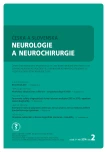-
Medical journals
- Career
REaDY – Czech Registry of Muscular Dystrophies
Authors: J. Strenková 1; S. Voháňka 2; J. Haberlová 3; MUDr. Jana Junkerová 4; R. Mazanec 3; L. Mrázová 2; O. Parmová 2; P. Ridzoň 5; J. Staněk 4; D. Šišková 5; P. Vondráček 2; P. Brabec 1; L. Šnajdrová 1
Authors‘ workplace: Institut biostatistiky a analýz MU, Brno 1; FN Brno 2; FN v Motole, Praha 3; FN Ostrava 4; Thomayerova nemocnice, Praha 5
Published in: Cesk Slov Neurol N 2014; 77/110(2): 230-234
Category: Short Communication
Projekt REaDY získal finanční podporu Ministerstva zdravotnictví v rámci 2. kola programu „Národní akční plány a koncepce“ na rok 2013.
Overview
Various forms of muscular dystrophies are mostly classified as rare diseases and rare diseases have received considerable attention from the European Union over the past few years. Based on the Council Recommendation of 8 June 2009 on an action in the field of rare diseases, the Czech government has embraced the National Action Plan on Rare Diseases, involving improvements in methodology of data collection on these diseases. The REaDY project (REgistry of muscular DYstrophy, http://ready.registry.cz) includes registries focusing on four types of neuromuscular disorders: Duchenne/Becker muscular dystrophy, spinal muscular atrophy, myotonic dystrophy, and facioscapulohumeral muscular dystrophy. As of 30th April 2013, REaDY registries contained data on 708 patients in total. Data from the REaDY project will lead to improvements in health care planning and predictions, including future estimates of financial costs, as well as costs and needs in the area of health technology (Health Technology Assessment, HTA). The costs are assessed from clinical data and from health care payers’ data.
Key words:
rare diseases – neuromuscular disorders – muscular dystrophies – clinical registries
The authors declare they have no potential conflicts of interest concerning drugs, products, or services used in the study.
The Editorial Board declares that the manuscript met the ICMJE “uniform requirements” for biomedical papers.
Sources
1. European Commission. Council Recommendation of 8 June 2009 on an action in the field of rare diseases (2009/ C 151/ 02). Official J Euro Commun 2009 : 7 – 10.
2. Vondráček P, Mrázová L, Haberlová J, Voháňka S, Brabec P, Strenková J. REaDY – REgistry of muscular DYstrophy. Dostupné z URL: http:/ / ready.registry.cz.
3. European Reference Networks for Rare Diseases. Dostupné z URL: http:/ / www.eurordis.org/ sites/ default/ files/ EURORDIS_Position_paper_on_ERN_May_2012.pdf.
4. TREAT ‑ NMD global patient registries: A unified global source of information about neuromuscular patiens. Dostupné z URL: http:/ / www.treat ‑ nmd.eu/ resources/ patient ‑ registries/ overview/ .
5. Nadkarni PM, Brandt C, Frawley S, Sayward FG, Einbinder R, Zelterman D et al. Managing atribute – value clinical trials data using the ACT/ DB client ‑ server database system. J Am Med Inform Assoc 1998; 5(2): 139 – 151.
6. Nadkarni PM, Brandt CM, Marenco L. WebEAV: automatic metadata‑driven generation of web interfaces to entity ‑ attribute ‑ value databases. J Am Med Inform Assoc 2000; 7(4): 343 – 356.
7. Nadkarni PM, Marenco L. Easing the transition between attribute ‑ value databases and conventional databases for scientific data. Proc AMIA Symp 2001; 483 – 487.
Labels
Paediatric neurology Neurosurgery Neurology
Article was published inCzech and Slovak Neurology and Neurosurgery

2014 Issue 2-
All articles in this issue
- Autonomic Dysreflexia – a Serious Complication of Spinal Cord Injury
- Orthostatic Hypotension as a Multifactorial Abnormality after Cervical Spinal Cord Injury
- A Comparison of the Validity of the McDonald Diagnostic Criteria for Multiple Sclerosis 2005 vs 2010 in the Clinical Practice
- Development of Neurological and Functional Clinical Picture after Spinal Cord Injury
- Correlation between Brain Tissue Oxygen Monitoring Parameters and Transcranial Dopplerometry in Patients with Severe Subarachnoid Hemorrhage
- Grammaticality Judgement in Broca’s Aphasia – Two Case Studies
- Normative Values of Nerve Conduction Studies of the Ulnar and Median Nerves Measured in a Standardized Way
- Evaluation of Volume Response of Low Grade Glioma to Radiochemotherapy treated for Inoperable Progression or Residual Tumor
- Influencing the Auditory Pathway in Patients with Vestibular Schwannoma Treated with Gamma Knife Radiosurgery
- REaDY – Czech Registry of Muscular Dystrophies
- Methanol Intoxication on Magnetic Resonance Imaging – Case Reports
- Cervical Epidural Abscess – Two Case Reports
- Dravet Syndrome: Severe Myoclonic Epilepsy in Infancy – Case Reports
- Nemaline Myopathy Associated with Monoclonal Gammopathy – a Case Report
- Neuromodulation
- Alcohol Withdrawal Syndrome and Delirium – from its Pathophysiology to Treatment
- Cerebral Vasospasms Following Subarachnoid Bleeding – Diagnosis, Monitoring and Treatment Options
- Czech and Slovak Neurology and Neurosurgery
- Journal archive
- Current issue
- Online only
- About the journal
Most read in this issue- Autonomic Dysreflexia – a Serious Complication of Spinal Cord Injury
- Dravet Syndrome: Severe Myoclonic Epilepsy in Infancy – Case Reports
- Normative Values of Nerve Conduction Studies of the Ulnar and Median Nerves Measured in a Standardized Way
- Neuromodulation
Login#ADS_BOTTOM_SCRIPTS#Forgotten passwordEnter the email address that you registered with. We will send you instructions on how to set a new password.
- Career

